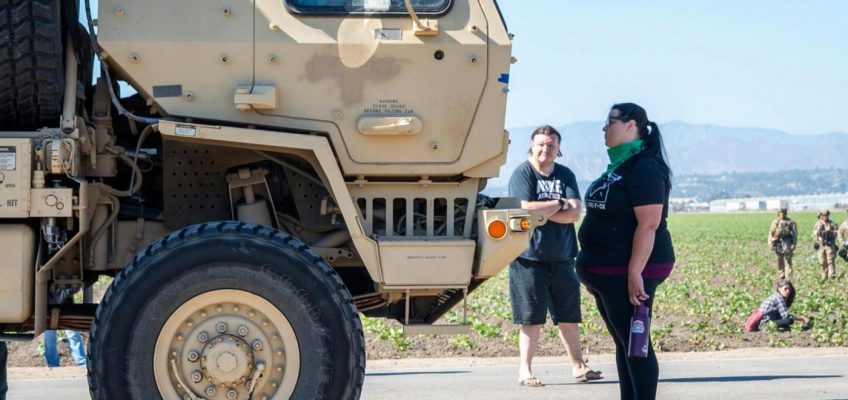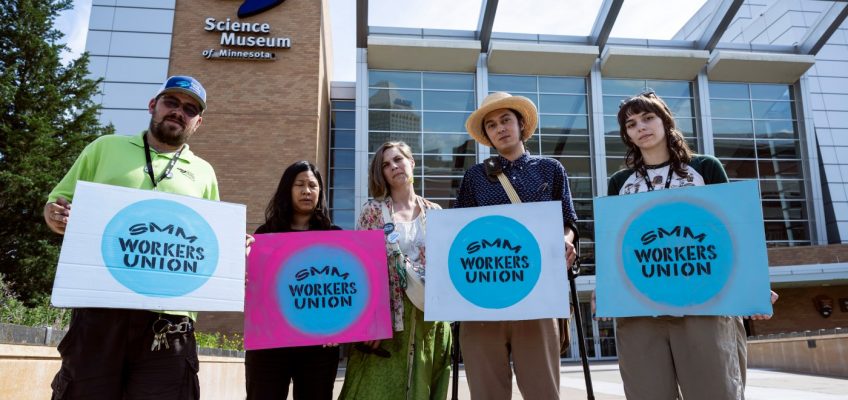By Raisa Habersham, Miami Herald
MIAMI — On Sunday, two men stood in front of Alligator Alcatraz to show support for the detention center. One held a sign that read, “Welcome to Paradise. Don’t feed the animals.”
The jokes about alligators attacking immigrants while in detention have been casually tossed around by President Donald Trump, Gov. Ron DeSantis and conservative and far-right influencers. The Florida GOP and Attorney General James Uthmeier are cashing in on “Alligator Alcatraz” merchandise, some that prominently feature alligators, to fundraise for campaigns. The ‘gators, in this case, are the good guys. The folks inside the detention center, no matter their story or status, are tempting treats for Florida’s newly deputized reptilian law enforcement.
The mocking of immigrant detainees harks back to “the worst parts of our history” when similar jokes and tropes, such as “gator bait,” were used to dehumanize Black people and desensitize people to the harm and violence inflicted upon them, says ACLU Florida Executive Director Bacardi Jackson.
The “gator bait” trope, which has been well-documented by the Jim Crow Museum in Big Rapids, Michican, implied that Black people don’t deserve protection against the hazards of nature. In the museum’s archive are articles detailing how Black babies, referred to by the slur pickaninnies, were used as bait to lure and kill Florida alligator.
Think Democrats and Republicans can’t work together? On eviction records, they do
Son of ‘El Chapo’ pleads guilty in US drug trafficking case
Here are some things you can do to be better prepared for major flooding
Texas floodwaters damaged crops and endangered livestock. Now farmers and ranchers are cleaning up
Walmart recalls 850,000 water bottles after two consumers suffer vision loss from ejecting lids
The National Museum of African American History and Culture’s archive features postcards depicting Black children sitting near swamps to lure alligators. And the same disregard for humanity is now being applied to detainees who will be housed in the detention center, historian Marvin Dunn told the Miami Herald. “Basically, the same kind of anger, the same kind of resentment is now being transferred to immigrants,” he said.
“These kinds of tropes and jokes were made as a way to keep people from thinking of Black people as human. And now, when we are in this situation where what is happening to immigrant people, who are largely Black and brown people, it’s the same exact thing. It’s the dehumanization,” said Jackson. “It’s the desensitizing [of] folks in the hopes of not having people rise up against such cruelty and treatment of others.”
Jackson said when people see political leaders make light of real danger to people, it gives others permission to be “callous, cold and hateful,” similar to when Gov. Ron Desantis told drivers it was OK to hit protesters during the recent No Kings protests against Trump if they felt they were being endangered.
“You have a right to flee for your safety, and so if you drive off and you hit one of these people, that’s their fault for impinging on you,” DeSantis told a podcast last month.
“It’s the invitation for others to see people as less than human,” Jackson said. “That one creates the environment where a government can come up with more cruel and harmful policies.”
Dunn said the term “gator bait” never left the lexicon, particularly in the South. White nationalists use the term all the time and it is an “inside” joke among certain groups. “Gator bait” entered the national conversation in 2020 amid George Floyd protests nationwide when University of Florida president Kent Fuchs issued a statement saying the university would no longer do their “Gator bait” cheer, which involved fans doing the Gator chomp with their arms to taunt opponents.
Concern about the treatment and conditions the detainees were facing at the detention center caused several state officials to appear outside Alligator Alcatraz and demand entry last week.
Florida state Sen. Shevrin Jones was among five elected state officials who attempted to enter the facility but were shut out. He will return Saturday during a scheduled visit for state legislators. Jones said he’s refusing to call the site “Alligator Alcatraz,” and questions the treatment of immigrants who are kept at the facility.
“It’s baffling to me that individuals have made this a Democrat or Republican issue when we’re talking about humanity and ensuring that individuals are being treated humanely,” said Jones, a Democrat who represents Miami Gardens and other areas in northern Miami-Dade. “It has turned so political where now individuals are justifying inhumane treatment for human beings.”
Jackson said the dehumanization of one group opens the door for more harm to come to everyone.
“Silence is consent. We have to pay attention to what’s happening,” she said.
©2025 Miami Herald. Visit at miamiherald.com. Distributed by Tribune Content Agency, LLC.




